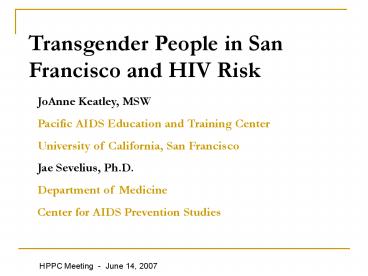Transgender People in San Francisco and HIV Risk - PowerPoint PPT Presentation
1 / 15
Title:
Transgender People in San Francisco and HIV Risk
Description:
... among samples of African American, Latina, and API transgenders in San Francisco. ... Latina (n=110) N (%) Afri.Am. ( n=112) N (%) Total (n=332) N ... – PowerPoint PPT presentation
Number of Views:113
Avg rating:3.0/5.0
Title: Transgender People in San Francisco and HIV Risk
1
Transgender People in San Francisco and HIV Risk
JoAnne Keatley, MSW Pacific AIDS Education and
Training Center University of California, San
Francisco Jae Sevelius, Ph.D. Department of
Medicine Center for AIDS Prevention Studies
HPPC Meeting - June 14, 2007
2
Transgender Population Estimates No U.S.
population-based studies yet conducted. However,
it is likely they would be problematic, due to
stigma-induced failure to disclose
identity. Current estimates are
transsexual-centric, i.e., focused on those who
fit the DSM definition of Gender Identity
Disorder or those who have had surgical sex
reassignment, even though transsexuals are a
minority within the overall transgender
population. Jessica Xavier, MPH
3
U.S. Transgender Behavioral Risk and Needs
Assessment Surveys, 1993 - present
- Universities, local health departments and
community-based organizations - Not all published in journals
- Copies of Technical Reports are difficult to
obtain - only limited numbers printed
- Some limited to sex workers or substance users
- Only a few include FTMs
- Trans youth data is difficult to collect
- Few incidence studies
- Jessica Xavier, MPH
4
U.S. Transgender HIV Prevalence Rates by City
(All MTF Unless Noted) Minneapolis St. Paul
4 San Juan 14 Philadelphia 4 to
19 Chicago 14 to 19 Los Angeles 22 New
York 21 to 30 Houston 27 Washington
32 MTF, 3.3 FTM Atlanta (sex worker)
68 San Francisco 25 - 47 MTF, 1.6 FTM
5
Prevalence Estimates in San Francisco
- Nemoto et. al (2004)
- MTFs of color 26 HIV (self-report)
- DPH (2002)
- MTF 25 HIV (self-report)
- Clements et. al (1999)
- MTF 35 HIV (Orasure)
- FTM 1.6 (n 2 of 123) HIV (Orasure)
- Nemoto et. al (1996)
- MTF 47 HIV (self-report)
6
SF Transgender Community Health
Project (Clements et. al, 2001) Predictors of
HIV Positive Status in MTFs
7
HIV Risk Behaviors among MTF Transgenders of
Color (Nemoto et. al, 2004 J. Keatley, Project
Director)
- Examined correlates of HIV-related risk behaviors
among samples of African American, Latina, and
API transgenders in San Francisco. - Sexual Behaviors primary, casual, and commercial
- Health Outcomes HIV/STD, Depression, Need and
Access to Care - Substance use Substance use (lifetime, past 30
days), injection drug use, engaged in sex with
primary, casual, or commercial partners while
under the influence of any illicit drugs - Psychosocial Factors (e.g., transphobia,
depression, self-esteem, gender identity, social
support)
8
Table 1. Demographics by Ethnicity
9
Table 2. HIV/STD by Ethnicity
10
Major Findings
- About three-quarters of the participants had
recently engaged in receptive anal sex with
primary, casual, and commercial sex partners. - A significantly higher proportion (47)had
recently engaged in URAS with primary partners
than with casual (26) and commercial partners
(12). - Current URAS with primary and casual partners,
but not commercial partners, was significantly
and independently correlated with having had sex
under the influence of drugs - HIV positive participants were 3.8 times more
likely to engage in receptive anal sex as well as
URAS with casual partners than HIV negative
participants, controlling for other variables.
11
- Major findings continued
- Although only 12 had reported URAS with
commercial partners in the past 30 days, this
risk behavior was significantly and independently
correlated with African American race (4.5 times
more compared with non-African Americans) and
lowest income level (less than 500 of monthly
income).
12
Risk Factors Driving HIV Transmission in
Transgender People Social Stigma ?
Discrimination, Harassment, Violence ?
Unemployment, Lack of Health Insurance, Poverty,
Homelessness Survival Sex Work ? Unprotected
Sex, Substance Abuse Gender Identity Validation
through Sex ? Multiple sex partners,
unprotected sex Lack of Regular Contact with
Medical Providers ? Lack of medical
screening, including HIV/STDs, increased
morbidity risks
13
Risk Factors Driving HIV Transmission in
Transgender People Culturally Incompetent
Prevention Methods ? Low Perception of Risk
(especially among FTMs), Low HIV/STD testing
rates Multiple Injection Risks (IDU, ISU,
IHU) Barriers to Access to Transgender Care
? self-medication through street hormones,
ISU Traditional reluctance by MSM-serving AIDS
Service Organizations to view transgender people
as part of their service community
14
Criticisms of Prevention Methods Used in
Transgender Populations MTFs cant identify
with messages and images that do not fit their
body or self-image - Clements, Wilkinson, Kitano
Marx, 1999 MSM does not accurately describe
male-to-female transgenders who, genetically
male, experience a female gender identity -
Kammerer, Mason, Connors Durkee, in Bockting
Kirk, 2001 Existing prevention education is not
inclusive of transgender people and oftentimes
makes assumptions about sex and gender that are
not applicable to their (anatomical) situation -
Bockting, Robinson Rosser, 1998
15
Comments and Discussion JoAnne Keatley,
MSW Joanne.keatley_at_ucsf.edu 415.597-4960 Jae
Sevelius, Ph.D j.sevelius_at_ucsf.edu 415-597-9183































